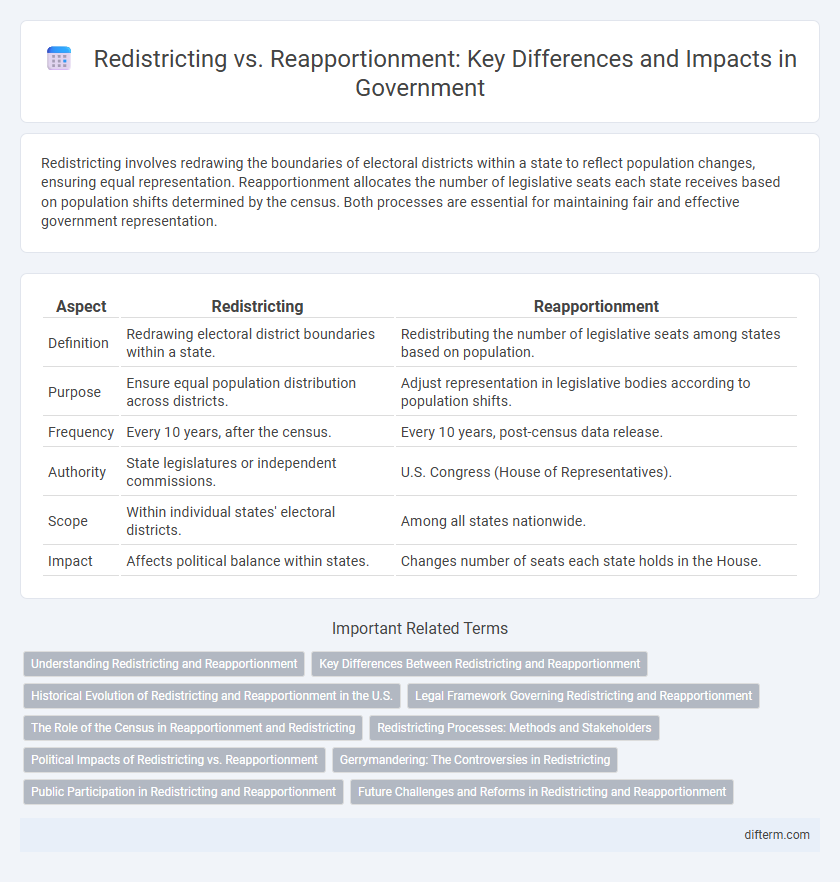Redistricting involves redrawing the boundaries of electoral districts within a state to reflect population changes, ensuring equal representation. Reapportionment allocates the number of legislative seats each state receives based on population shifts determined by the census. Both processes are essential for maintaining fair and effective government representation.
Table of Comparison
| Aspect | Redistricting | Reapportionment |
|---|---|---|
| Definition | Redrawing electoral district boundaries within a state. | Redistributing the number of legislative seats among states based on population. |
| Purpose | Ensure equal population distribution across districts. | Adjust representation in legislative bodies according to population shifts. |
| Frequency | Every 10 years, after the census. | Every 10 years, post-census data release. |
| Authority | State legislatures or independent commissions. | U.S. Congress (House of Representatives). |
| Scope | Within individual states' electoral districts. | Among all states nationwide. |
| Impact | Affects political balance within states. | Changes number of seats each state holds in the House. |
Understanding Redistricting and Reapportionment
Redistricting involves redrawing the boundaries of electoral districts based on population changes reported in the decennial census to ensure equal representation. Reapportionment is the process of reallocating the number of legislative seats each state receives in the House of Representatives following the census data. Both processes are critical for maintaining fair and effective representation in government, reflecting shifts in population demographics and political balance.
Key Differences Between Redistricting and Reapportionment
Redistricting involves redrawing the boundaries of electoral districts within a state to reflect population changes, while reapportionment reallocates the number of congressional seats each state receives based on the decennial census. Redistricting is carried out by state legislatures or independent commissions, focusing on equalizing population among districts, whereas reapportionment is a federal process that distributes the 435 House seats among states. The key difference lies in redistricting adjusting district lines within states and reapportionment altering state representation in Congress nationally.
Historical Evolution of Redistricting and Reapportionment in the U.S.
Redistricting and reapportionment in the U.S. have evolved significantly since the country's founding, with reapportionment mandated by the Constitution's Article I to redistribute House seats every ten years based on census data. The landmark Supreme Court cases Baker v. Carr (1962) and Wesberry v. Sanders (1964) established the principle of "one person, one vote," ensuring equitable district populations. Over time, redistricting became a politically charged process, influenced by demographic changes, civil rights legislation, and efforts to combat gerrymandering.
Legal Framework Governing Redistricting and Reapportionment
The legal framework governing redistricting and reapportionment is primarily rooted in the U.S. Constitution, specifically the Fourteenth Amendment, which mandates equal population distribution across districts. Federal laws such as the Voting Rights Act of 1965 play a critical role in preventing racial gerrymandering and ensuring fair representation. Court rulings, including landmark Supreme Court cases like Baker v. Carr and Shaw v. Reno, establish important precedents for judicial review and the protection of voters' rights in redistricting processes.
The Role of the Census in Reapportionment and Redistricting
The U.S. Census provides critical population data every ten years that directly influences reapportionment by determining the number of congressional seats allocated to each state. This population data guides redistricting efforts at the state and local levels, ensuring districts reflect shifts in demographic distribution for fair political representation. Accurate census counts underpin the integrity of both reapportionment and redistricting processes, impacting legislative and electoral boundaries nationwide.
Redistricting Processes: Methods and Stakeholders
Redistricting processes involve redrawing electoral district boundaries to ensure equal population representation, primarily using geographic information systems (GIS) and demographic data to create balanced districts. Key stakeholders include state legislatures, independent commissions, and courts, each playing a critical role in overseeing transparency, adherence to legal standards like the Voting Rights Act, and preventing gerrymandering. Public input is often solicited to enhance fairness and community representation, reflecting shifts in population as identified in the decennial census.
Political Impacts of Redistricting vs. Reapportionment
Redistricting changes electoral district boundaries, significantly influencing political power distribution by potentially altering the balance between parties within states. Reapportionment reallocates congressional seats among states based on population shifts following the census, impacting national political representation. Together, these processes can affect legislative priorities, election competitiveness, and voter influence across regions.
Gerrymandering: The Controversies in Redistricting
Gerrymandering, the practice of manipulating electoral district boundaries to favor a political party, represents a major controversy in redistricting. It undermines democratic principles by diluting the voting power of certain populations, often leading to unequal representation in legislative bodies. Legal challenges and reform efforts persist as states seek to create fairer district maps while maintaining compliance with the Voting Rights Act.
Public Participation in Redistricting and Reapportionment
Public participation in redistricting and reapportionment is essential for ensuring transparency and fairness in the political process. Citizens can submit feedback, attend public hearings, and engage with independent commissions to influence the drawing of electoral boundaries. Enhanced public involvement helps prevent gerrymandering and promotes districts that accurately reflect community interests and demographic changes.
Future Challenges and Reforms in Redistricting and Reapportionment
Future challenges in redistricting and reapportionment include addressing gerrymandering, ensuring equal representation amid population shifts, and incorporating advanced data analytics for transparency. Reforms focus on establishing independent redistricting commissions, enhancing legal frameworks to prevent partisan bias, and leveraging geographic information systems (GIS) technology for accuracy. Balancing demographic changes with fair political boundaries remains critical to maintaining democratic integrity.
redistricting vs reapportionment Infographic

 difterm.com
difterm.com